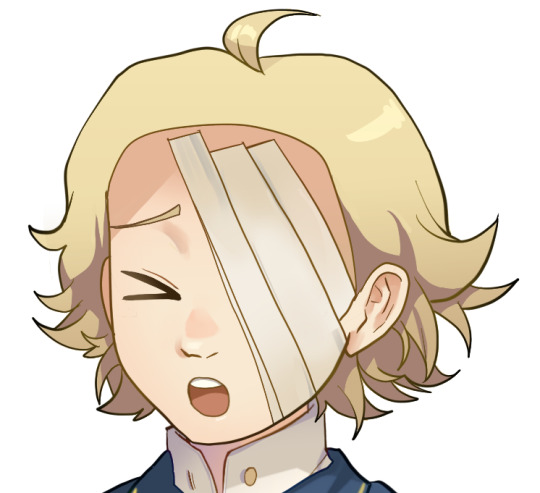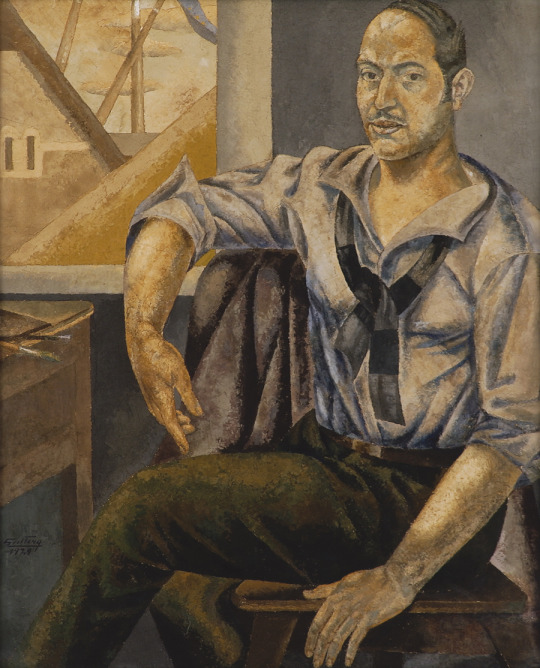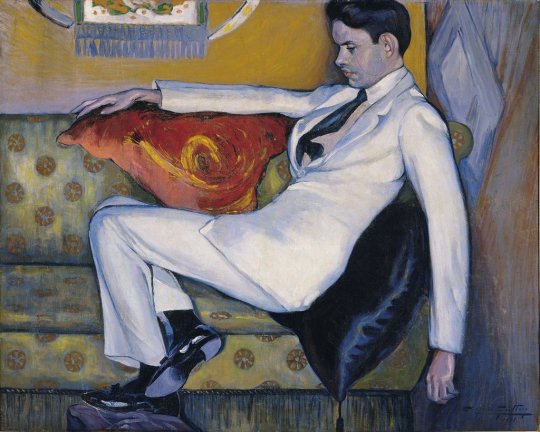#if hes wearing his jacket/hat or not; his expression; and the presence/absence of james
Explore tagged Tumblr posts
Note
I sent an ask being curious about the new Oliver art you mentioned, it must have not gone through- -🌟
it must not have yea :'0 i never saw it pop up in my inbox or anything
but ya if you're curious! you can get it here it's free 👁️👁️
it comes w/ a normal, default png, as well as a .CLIP file and a .PSD file
i assume clip is for clip studio paint or smthn but idk idc lmao since i dont use csp
the .psd comes with a bunch of extra eyes, brows, mouths, etc to give him different facial expressions. you can also remove his jacket and hat (and make his whole body disappear as well...), add/remove james, and, for some reason, you can take away his bangs...?

but ya. then when you're done w/ your creation you can save it as a transparent png and overlay on smthn else for meme purposes as i do (or DO SOMETHING BETTER W/ IT KSJDGHK)
#ask#still no reveal for wtf is under his bandages tho lmao... forever a mystery#IM ASSUMING MAYBE THE BANGS THING IS LIKE. FOR HIS HAT?? cause it doesnt look as. scary. when you have his hat on lmao#like i said: its like a lil fcked up dress up doll sorta LMAOO except yknow. really the only things you can mostly change are#if hes wearing his jacket/hat or not; his expression; and the presence/absence of james#i loveee some of the new art oliver's been getting yes boy yes... i think the illustrator has a tumblr but i dont know the url :(#i feel so bad though ahkjdskjgnk genuinely this is a very nice drawing of him but. already the memes have started HSKDJGHK#THE SAME CAN B SAID FOR A LOT OF OFFICIAL ILLUSTRATIONS TBH. someone out there spent a lot of time and effort on that#and then there's people like. editing shitty ms paint tears over em with fire in the bg (aka people is me) SO AJHKSJGK.#star anon ollie
2 notes
·
View notes
Text
Alfredo Guttero
Who: Alfredo Guttero
What: Artist and Art Promoter
Where: Argentinian (active in Argentina and throughout Western Europe)
When: May 26, 1882 - December 1, 1932

(Image Description: Retrato del pintor, Victorica, 1929 [a self portrait]. It shows Guttero in his apartment. Outside is a very geometric skyline of smokestacks, steep roofs, and a brown sky. His room is slate colored and he sits in a chair in the foreground. He has a jacket thrown over the back of his chair. His pose is casual and he looks as if we [the viewer] have just distracted him from painting. He sits with his legs to one side, turned almost unnaturally toward the viewer. One leg is lifted slightly and one hand is on the chair's seat as if he is in the middle of turning completely to the viewer. He is a man with a receding hairline and a high forehead. He has a dark mustache and dark hair and low eyebrows. He is wearing a white shirt and bowtie and has his sleeves rolled up to the elbow and his collar is ruffled and loosened. The whole thing hangs very loose but you can still see some of his body's lines of musculature. His tie undone and hanging around his neck. His pants are ordinary and green/brown. His expression is calm but confident and he looks directly at the viewer. The colors are bold but not really bright. The style blends geometry and flatness and realism in a way I am explaining very poorly. End ID)
Guttero is not terribly well remembered today, which is too bad. Looking through his oeuvre I quite like his work. Maybe it is because he lacked the bombastic personality of many modernist artists, maybe it is due to his diversity of styles without one that seems to define his work, or maybe it is because he was one of so many talented artists of his generation. He was well renown in his era, however, and used his popularity and skill to foster the next generation of Argentinian artists.
Guttero's life began mundanely enough. He always loved art, appreciating it and creating it, but pursued a legal career instead. But he was unhappy with his life as a lawyer, so Guttero left it to become a painter. He pursued his dream and passion, inspired and pushed by other Argentine artists. In 1904 his reputation was good enough that the Argentinian government sponsored his move to Paris, then the epicenter of the truly exciting and revolutionary art world, its influence expanding outward. He studied there for a few years under Maurice Denis before appearing in the Salon.
He remained in Paris until 1916 when he began to travel extensively across Western Europe for more than a decade, first to Spain, then Germany, Austria, and beyond. He traveled to nearly every country in the area between the years of 1916 and 1927. His work was shown in various exhibitions around the continent from being featured in the Salon in Paris to a major solo exhibition in Genoa.
After that he returned to Argentina for the first time since his initial departure in 1904. Guttero remained active in his native country including creating free art classes called, aptly enough, Cursos Libres de Arte Plástico, with other Argentine artists. During this time he focused on his work as an art promotor, perhaps even more than his own art. During this time he introduced and showed new Argentinian artists to a wider audience. Indeed he created an organization for this purpose: the Hall of Modern Painters. He was dedicated to promoting and preserving modern art in the face of a world growing increasingly dark and reactionary. He died young and without much warning.
His art is undeniably modernist but trickier to pin to a specific movement. He has many different styles he utilizes with different degrees of naturalism and curves vs geometry. His scenes are by and large mundane and human, he uses bright colors, often huge central subjects, kinetic poses and positions, modern settings, and by and large human or urban subjects. He often painted on plaster using a "cooked plaster" technique of his own devising.

(Image Description: Martigues for Charles Jacques [1909], a brightly colored painting showing a scene in a Martigues canal. It is not completely realistic nor completely geometric and abstract. He favors color over outlines. In the background is a bright blue sky interrupted by yellow buildings with tile roofs, maybe houses, lit by the unseen sun. One of the building's lower doors is open. There is a small tree to the far right. In the foreground in the sparkling water of the canal are several small work boats, probably fishing boats judging by the silvery nets lying over the hulls. On the right a boat is coming in, there is a pale skinned, dark haired man working on one of the nets. His sail is red and white. On the left is a pale man in an orange hat and yellow shirt. He is stooped and just by his pose appears older, both of the men are too far away for many identifying details. End ID)
Possible Orientation: Mspec ace, gay ace, or aroace with an aesthetic attraction to multiple genders. (I am so unsure I have changed "probable" to "possible.")
I admit this one is a stretch on my part.
I am classifying Guttero based largely on absence, i.e. the absence of a remembered/recorded spouse, sexual/romantic partner, or liasian. I have no quotes or historical documents to prove my point. I have none of his personal philosophy or writings to draw from. Just the fact that he dedicated his life to art more than human relationshipa. That this is something I have seen before: Cause and its role in the life of many aros/aces/aroaces (outlined in Weil's entry the other day) and the fact that he had no recorded romantic/sexual partners that I can find in hours of research.
This illustrates why it is so, so difficult to find aspecs in history. We are not, as aphobes believe, impossible to locate, there is externally visible evidence, but it is less obvious than most other orientations. And cishets would rather we didn't exist so we are often buried under excuses. The easiest ways to find them are 1) if they were notably "married to their job" in their lifetimes (e.g. Jeanette Rankin and Carter Woodson), they talked/wrote about it in some capacity (e.g. T.E. Lawrence or Frédéric Chopin), they were distrusted because of it (John Ruskin and James Barrie), they made it part of their persona (Nikola Tesla and Florence Nightingale), aside from that I really need to search deep into their personal lives. Information not always available.
And often even when people essentially say "I am aromantic and/or asexual" the general population will not accept that. After all Newton is often remembered as allo and gay, despite never expressing interest in men. Chopin is often listed as allo and bi. Rankin is often considered cishet but too deeply concerned with her work. Barrie gets called a pedophile despite showing no interest in children. For eccentric aspecs like Weil/Tesla/etc. their being aspec becomes part of their oddness. If they weren't Like That they would be allo. Their being aspec becomes a symptom of their weirdness and would be unacceptable in a "normal" person.
History with a capital H does not want to acknowledge aspecs and, as with other queer identities, will go to insane measures to erase them. But even other queer historians will do this to aspecs. I am shocked how many people do exactly to Newton/Lewis/and the like what cishet historians do to Alexander the Great. In the case of Alexander the cishets ignore the obvious accounts that he loved Hephestian in nearly every way possible and queer historians and history buffs call them out, then often the non-aspec ones look at Newton and Lewis who had no interest in men and say they must have been gay. And it isn't really just history, Tim Gunn is by his own admission both gay and ace and the second part of that statement is either erased or, even crazier, I have seen aphobes say that he is mistaken about his own identity.
Anyway the root cause of this lack of nuance in the discussion of sexual orientation is a long sidebar that this is not the place to explore. I have left Guttero behind paragraphs ago. I have written a lot about how aces and aros end up getting erased from history and this isn't about that.
This is about Guttero and the difficulty of finding aros and aces. The presence of something is so much easier to find than the alternative, obviously, like if Historical Figure X exclusively slept with/courted men and was a man we can say he was (most likely) gay. But if Historical Figure Y didn't sleep with anyone/court anyone it is harder to prove. This is obviously severely simplifying identity but for the purposes of this example I beg your apology.
Long Story Short: the absence of evidence of something is not proof of the absence of something. A lot of aphobes will point this out and utterly ignore the fact that sometimes it is.
So, Guttero. The only thing I can say conclusively is that he never married and he was romantically or sexually tied to anyone as far as I can find. He was, in his time, very active in the art world. If he had been involved someone would probably have taken note. Especially considering his art is often very appreciative of the human form, especially the male one, it would not be hard to believe he was allo and gay or mspec.
I am going to take his art another way putting some dusty analysis/critique/art history skills to good use. Here's the thing, those who follow me on my personal blog or even here know I find the Death of the Author extremely important but it is also extremely complicated (it was actually the topic of my senior thesis). I don't want to use an artist's work to talk about their personal lives because art is often not reflective of life, but there is always some cross contamination in one way or another. I am going to explain what I mean on a superficial level, using myself as an example so I can say this is 100% accurate. I love the found family trope, and I think those relationships are the best in the world. So whenever I write something you can be damned sure if I can get some found family goodness in there I will. What I am saying is, I don't love or even approve of everything I write about, but I do write about some things because I love them and want to explore them and experience them on some level. The same may be true for Guttero and the subjects he painted.
Guttero often pays a lot of attention to human form. Look at his work The Market (I couldn't find a large enough image to put it in this post) and you will see his appreciation for amab musculature and on the other side of the male spectrum...

(image description: Retrato de Lucien Cavarry [1911] It shows a thin, lanky, and well dressed young man reclining on a green floral patterned couch and a black pillow. He is pale with neat, dark hair. He has a shadow of 5 o'clock shadow on his super hero jaw. His suit is white, his slightly rumpled tie is black, as are his socks and polished shoes. One arm is across the back of the couch and a red and gold pillow the other is dangling. This style is very different from the other portraits I showed/referenced. Still a modern but more realistic style, more flowing, less geometric. The man is drop dead gorgeous by Western beauty standards. End ID)
As for women...he seems to find them colder, more distant, but there is still a physical appreciation there. (Linking Mujeres Indolentes so I don't get flagged for "female presenting nipples" or whatever Tumblr's BS is. [The name alone tells you a lot]). Or the somewhat judgemental gaze of the woman below:

(Image Description: Georgelina. It shows a portrait of a pretty young woman sitting in front of a field. She is pale and long and beautiful. She has red hair, sharp eyes, a long flowing white dress with a gold sash around her waist, and a white hat with a black bow that is blowing in the wind. She takes up most of the frame and her expression is challenging and she holds eye contact with the viewer. The colors are bright and she is almost porciline in color. The background is mostly flat planes of color. In style it is somewhere between the self portrait and the portrait of Cavarry. End ID.)
Not all of his portraits of women have them so sour/distant but they all have a sort of challenging look. Beauty tinged with something dangerous, while the men always seem more innocent.
So here is why I say aspec rather than allo using his work alone, none of his work is particularly sexually inviting even with the sexiness/physical European attractiveness. The men are bashful or unaware of the viewer, the women are certainly not interested.
And back to the self portrait at the top: Guttero is in a fairly sexy pose, but it is sexy without being sexual. He is rumpled but the thing he was doing was painting, there is a sexless explanation. He is looking at the viewer, but you are distracting him from working. At first glance I thought his legs were spread, but they are simply in motion so he can face his guest more comfortably. This all could mean nothing, but I found it striking that this is how he chose to depict himself, at first he appears to be inviting the viewer in for a more physical interaction, but then it seems he is doing exactly the opposite, his passionate energy has been instead put into painting.
And in reality toward the end of his life that was what he did. He dedicated himself to his own art and the art of others.
So again, this could mean nothing. But...it could mean he is aspec.
And that is how the person I am least sure about got the longest entry.

(image description: Elevadores [1928]. A painting showing a factory complex. There is a raised platform running around it and several buildings in bright colors. There is a tree to the right side and a green hill. The building in the near-center [lightly left] is red. The sky is yellow and blue, perhaps the unseen sun is rising up behind the right-hand buildings. In style it is mostly geometric and flat color. End ID.)
#queer#lgbtq#asexual#ace#history#aromantic#aro#gay#mspec#20th century#artists#south america#Argentina#Argentinian#Alfredo Guttero
16 notes
·
View notes